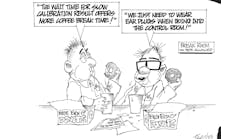The Honeywell agreement developed with Krohne for level and flow products is significantly different from that adopted by Rockwell with E+H. In 2008 issue, Jack Bolick, the previous president of Honeywell Process Solutions (HPS) described its aim as not to develop a competitive instrument portfolio, but to add instrumentation capabilities in areas like level, flow and corrosion, to enable HPS to deliver a complete solution. Bolick had set up the deal with Krohne and overseen the acquisition of Enraf tank gauging systems.
Last December the INSIDER expressed surprise that Krohne was not visible at the Honeywell User Group meeting in Barcelona. There Enraf systems were a major feature, and another small display showed some process instruments that apparently included an HPS branded Coriolis meter.
Honeywell Approach
Jack Roushey, the USA-based global product marketing manager for flow and level for HPS, explained the rationale over these products. The Krohne strength is seen as in the flow products themselves: HPS has tested various models for compatibility with HPS systems and re-written the specifications to define the hardware and software required for versions to be produced for HPS alone. These are then manufactured as HPS products, complete with Honeywell hazardous-area approvals and manuals, and over the last three years the HPS sales offices and staff have had the necessary flow expertise and training added.
This approach has been applied to Coriolis meters, a clamp-on ultrasonic flowmeter, magnetic and vortex flowmeters, and some level measurement systems—using radar and guided wave radar principles, all specified and targeted at the process instrumentation market. The level products are not seen or positioned as competitive with the Enraf tank contents gauging systems. Since Krohne has no current wireless capability with its sensors, there is no conflict with the HPS range of wireless field transmitters. To meet new niche market applications, developments and enhancements to the product ranges are continuing. Roushey mentions the moderate success already achieved using the Modbus output direct from the Coriolis flow sensor into PLCs controlling stand-alone special purpose skids, which effectively reduces the Coriolis meter system cost for skid builders.
HPS is pleased with the development of the business for this product range, and Roushey suggests there has been no significant problem in any overlap between HPS and Krohne sales activity, since the target markets and standard types of business differ between the two companies. A key market area for Honeywell, he suggests, is in oil refining, where it has found significant business for larger size Coriolis meters. Possibly the refinery situation in Europe and the strength of Krohne in Europe explains why these HPS products were only present in a small display at the User Group November 2010 meeting in Barcelona.


